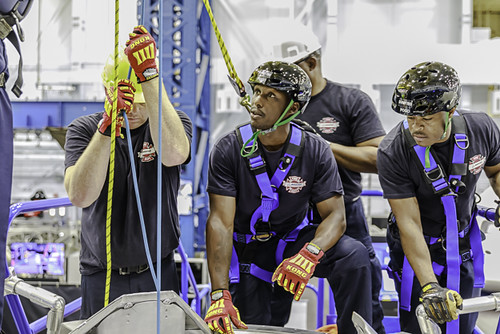
Introduction
Confined Space Oxygen Level : In industries and workplaces, workers may encounter confined spaces during their routine tasks. These spaces, which are not designed for continuous human occupancy and have limited entry and exit points, pose potential risks to workers’ safety and health. One critical factor that needs to be carefully monitored in confined spaces is the level of oxygen present. In this article, we will delve into the significance of oxygen in confined spaces, the dangers of low oxygen levels, measuring techniques, safety practices, and legal regulations related to confined space entry.
Confined Space Oxygen Level
What Is a Confined Space?
Before understanding the importance of oxygen levels, it is essential to define what constitutes a confined space. Confined spaces are areas that are not meant for human habitation but may require occasional entry for maintenance, repair, or inspection purposes. Examples include storage tanks, silos, tunnels, crawl spaces, and utility vaults. Such spaces often have limited ventilation, making them susceptible to oxygen depletion and accumulation of hazardous gases.
The Significance of Oxygen in Confined Spaces
Oxygen is a vital gas that supports human life and various combustion processes. In confined spaces, the presence of an adequate oxygen supply is critical for the safety and well-being of workers. Without sufficient oxygen, workers may face serious health risks, and certain work activities might lead to combustion hazards.
Understanding Oxygen Levels
The level of oxygen in a confined space is measured as a percentage of the total air volume. Normal atmospheric air contains approximately 21% oxygen. However, oxygen levels below 19.5% can lead to oxygen deficiency, while levels above 23.5% can increase the risk of fire and explosions.
Dangers of Low Oxygen Levels
When oxygen levels in confined spaces drop below the safe range, workers may experience symptoms like dizziness, rapid breathing, and confusion. In extreme cases, lack of oxygen can cause loss of consciousness and even prove fatal. Moreover, low oxygen levels can also hinder the effectiveness of respiratory protective equipment.
Measuring Oxygen Levels in Confined Spaces
To ensure the safety of workers, it is crucial to regularly monitor oxygen levels in confined spaces. This is achieved using portable gas detectors that measure the concentration of oxygen in the air. Regular calibration and maintenance of these devices are essential to ensure accurate readings.
Factors Affecting Oxygen Levels
Several factors can influence the oxygen levels in confined spaces. Oxygen depletion can occur due to processes like combustion, rusting, or biological activities. Additionally, the presence of other gases and contaminants can also displace oxygen, leading to hazardous conditions.
Safe Oxygen Levels in Different Environments
The required oxygen levels may vary depending on the type of confined space and the specific tasks performed within. For instance, while 19.5% is the minimum safe level for most confined spaces, certain environments may require higher oxygen concentrations to ensure worker safety.
Maintaining Safe Oxygen Levels
Maintaining adequate oxygen levels in confined spaces is paramount. Proper ventilation through natural or mechanical means can help restore and regulate oxygen concentrations. Moreover, workers entering confined spaces must wear appropriate personal protective equipment (PPE) to safeguard against oxygen deficiency.
Training and Education
Ensuring the safety of workers in confined spaces involves comprehensive training and education. Workers should be aware of the hazards associated with confined spaces and understand the importance of monitoring oxygen levels during entry and work.
Legal Regulations and Standards
Various organizations and government bodies have established regulations and standards for working in confined spaces. For instance, the Occupational Safety and Health Administration (OSHA) in the United States has specific requirements for confined space entry, and non-compliance can lead to severe penalties.
Case Studies
To emphasize the significance of oxygen levels in confined spaces, let’s explore real-life incidents where oxygen played a crucial role. These case studies will provide valuable insights into the potential risks and help us identify preventive measures.
Best Practices for Confined Space Entry
Safe entry into confined spaces requires meticulous planning and adherence to best practices. Pre-entry procedures, checklists, and continuous communication among team members are essential for a successful confined space operation.
Emergency Response Plans
Despite taking all necessary precautions, emergencies can still occur in confined spaces. Having well-defined emergency response plans and conducting rescue drills regularly can save lives in critical situations.
Conclusion
In conclusion, maintaining appropriate oxygen levels in confined spaces is paramount for ensuring worker safety and preventing hazardous incidents. Employers must prioritize proper training, regular monitoring, and compliance with legal regulations to create a safe working environment. By taking these measures seriously, we can mitigate risks and protect the well-being of workers.
FAQs
- Why is oxygen level monitoring crucial in confined spaces? Proper monitoring of oxygen levels ensures the safety and well-being of workers, preventing potential health risks and fire hazards.
- What is the minimum safe oxygen level for confined spaces? The minimum safe oxygen level is 19.5%. Oxygen levels below this threshold can lead to oxygen deficiency and related health issues.
- How can workers protect themselves from low oxygen levels? Workers must wear appropriate personal protective equipment (PPE) and follow safety protocols during confined space entry.
- What are some common factors that affect oxygen levels in confined spaces? Oxygen levels can be affected by processes like combustion, rusting, and the presence of other gases and contaminants.





















